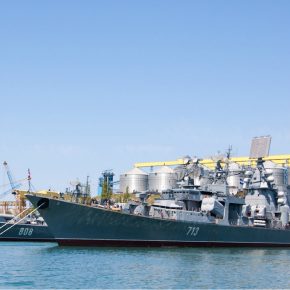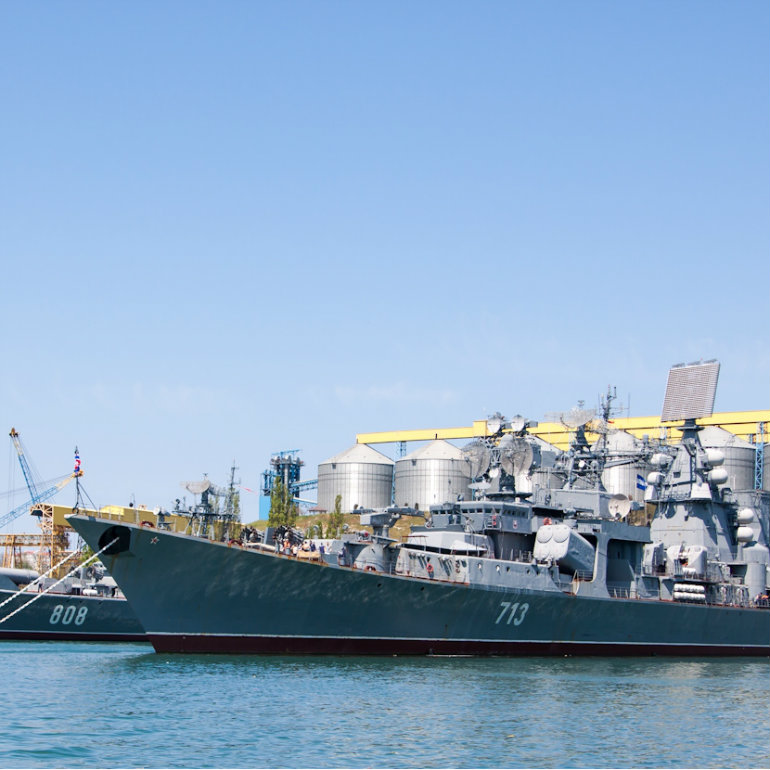Russia is too small to win the war in Ukraine
Category: Macroeconomics

Sevastopol, Ukraine/Russia (Sergii, CC BY-NC)
“Since the end of the Cold War, the Black Sea region has been a testing ground for Russia’s application of its ‘shadow war’ against Western interests and to suborn the littoral states,” the report argues.
“Moscow’s primary strategic objective under the Vladimir Putin presidency is to create a Eurasian ‘pole of power’ or bloc of states under predominant Russian influence that will necessitate containing, undermining and reversing NATO influence throughout Europe’s east,” the report states.
Even where it cannot pressure or entice its neighbors to integrate in the Eurasian Economic Union (EEU) and the Collective Security Treaty Organization (CSTO), the Kremlin is attempting to neutralize nearby capitals by preventing them from moving into Western institutions, particularly NATO and the EU, the report argues.
The Black Sea region forms the key intersection linking mainland Europe, Russia, the Caucasus, the Middle East and Central Asia.
For more than two centuries, Russia had endeavored to establish exclusive control of the Black Sea and has waged numerous wars against Turkey in order to capture the Bosphorus Straits and lock the Black Sea for its own use and during the Cold War the Black Sea was a virtual Soviet lake.
Western influences expanded during the 2000s, when Romania and Bulgaria joined NATO, while Ukraine and Georgia asserted their pro-Western orientations to deter Russia’s unwelcome interventions.
“Moscow’s revived attempts to control the Black Sea not only undermines the independence and territorial integrity of Ukraine, Moldova and Georgia, but also directly challenges the security of Romania, Bulgaria and Turkey,” the report argues.
The Black Sea region also has enormous economic potential, as a transit for goods and with a continental shelf that possess abundant natural resources including natural gas deposits.
“With a growing naval presence, Moscow could disrupt energy supplies through pipeline connections between the Caspian Basin and Europe that bypass Russian control. This would also curtail U.S. and European economic connections with Central Asia,” according to the report.
Russia is using the Black Sea as a more advantageous method of revisionism than extensive land conquests. Control of ports and sea lanes delivers several benefits: it prevents NATO from projecting sufficient security for its Black Sea members; deters the intervention of littoral states on behalf of vulnerable neighbors; threatens to choke the trade and energy routes of states not in compliance with Russia’s national ambitions; and gives Moscow an enhanced ability to exploit fossil fuels in maritime locations. Numerous tools of pressure are applied to ensure the fundamental goal—dominant influence over the foreign and security policies of immediate neighbors so they will either remain neutral or support Russia’s international positions.
Moscow formulated a revised maritime doctrine in July 2015, which focused on creating an A2/AD (anti-access, area denial) zone in the Black Sea, while ensuring a growing threat to the alliance’s southeastern flank.
It accomplished the first stage of containing NATO in the Black Sea in August 2008 following the invasion and partition of Georgia and the recognition of Abkhazia and South Ossetia as separate states. This sealed Russia’s dominance along the eastern Black Sea littoral. Since that time, Russian forces have boosted their presence in occupied territories and constitute a constant threat to Georgian stability, while effectively freezing Tbilisi’s progress toward NATO accession.
The Kremlin has also manipulated the dispute between Armenia and Azerbaijan over occupied Azerbaijan territories, including Nagorno-Karabakh, in order to maintain primary influence as a mediator and arms supplier to both sides in the conflict and to prevent a resolution that would sideline Moscow – the report goes on.
Russia is pursuing control over the northern Black Sea littoral following the annexation of Crimea from Ukraine in March 2014 and incitement of a proxy insurgency in Ukraine’s Donbas region. Ukraine remains frustrated that NATO refuses to supply it with offensive military equipment that could help it ward off Russia’s ongoing invasion. As the Kremlin cannot currently carve out a Novorossiya entity along Ukraine’s southern coastline—largely because of Ukrainian resistance—it will probably settle for Crimea and Donbas for the time being and seek to destabilize Kyiv’s pro-Western government. The underlying goal toward Ukraine, Georgia, and Moldova is to prevent these countries from moving into Western institutions.
Control of Crimea expands Russia’s maritime borders and its gas and oil fields. Moreover, the economic zones of Russia and Romania have become de facto adjacent; in effect, Russia now shares a maritime border with NATO and the EU in the Black Sea.
Moscow has more than halved Ukraine’s coastline and controls the country’s access to open Black Sea waters. It is thereby establishing dominion over vast oil and gas reserves off the Crimean shore and damaging Ukraine’s hopes for energy independence.
Moscow has largely subdued the Black Sea’s southern littoral, as Turkey has not challenged Russia’s gradual expansion and is preoccupied with conflicts along its own southern borders. Along the Black Sea’s western littoral, Kremlin objectives are to neutralize NATO’s eastern flank and ensure that Bulgaria and Romania do not oppose Moscow’s international offensives while NATO militaries cannot deter its maritime deployments. The Kremlin subverts and weakens its neighbors through a host of instruments and pressures. It does not need to deploy overwhelming military force to achieve its objectives but relies on the element of surprise, camouflage and deception. Potential scenarios of instability could involve further splitting Ukraine by linking Crimea with Moldova’s separatist region of Transnistria, strategically closing in on the Bosphorus Straits, gaining control of the mouth of the Danube and transforming Moldova into a satellite state.
In Moscow’s non-military strategy, various “soft spots” are exploited for penetration, including intelligence services, police forces and military structures.
Russia’s new military doctrine issued in December 2014 depicts an increasingly threatening foreign environment. It claims that intensifying threats emanate from NATO and the United States in particular, including the placement of Western forces in countries adjoining Russia and NATO’s development of ABM, space-based and rapid reaction forces. Moscow is responding to alleged NATO provocations by deploying new offensive nuclear weapons aimed at Western nations, developing an air and missile defense system and producing new precision-guided weapons.
Russia is building up weapons systems in the Black Sea region for purposes of power projection and political intimidation. When fully developed, these systems—including missiles, naval aviation jets and long-range bombers—could isolate the Black Sea basin and NATO allies therein from the rest of the alliance.
Since its attack on Ukraine, Moscow has enhanced its status as a maritime power in several ways. Its Black Sea fleet is positioned to deny military access to the Caucasus and to Ukraine. The integration of Crimea provides Russia with an additional coastline of several hundred kilometers, together with the crucial Black Sea port of Sevastopol. The Black Sea Fleet has been incorporated into Russia’s southern military district. It now fulfills several tasks, including securing navigation and sea lines of communication, countering the presence of naval groups of NATO forces, supporting units coming from other Russian fleets operating in the Mediterranean and maintaining leverage over energy supplies from the Caspian Basin to Europe. The expansion and modernization of the Black Sea fleet has become one of the Kremlin’s highest priorities. By 2020, Russia plans to significantly enhance its military presence in Crimea, while deploying additional mobile missile coastal forces.
Maritime power is the ability of a state to use this sphere to achieve specific policy objectives. In the case of the Black Sea, Russia can concentrate its forces in a relatively small area to gain advantage, whereas NATO has limited access to these waters largely because of stipulations in the 1936 Montreaux Convention. Moscow seeks to develop a naval force that can dominate the Black Sea and expand Russian presence in the Mediterranean. At the same time, it retains the option of a pre-emptive nuclear strike when a military attack—whether from nuclear or conventional weapons—allegedly threatens the integrity of the Russian state.
The Kremlin has embarked on a long-term rearmament program designed to significantly strengthen its multi-regional naval power. Russia’s bold Maritime Strategy document, issued in July 2015, declared a dramatic increase in the production of high-technology capabilities, with a significantly bolstered military presence in the Baltic, Caspian and Black seas. It emphasizes buttressing Russia’s non-nuclear deterrence, with an investment in both short- and long-range high-precision strike systems. Such systems constitute a major threat to NATO states bordering the Black Sea. Moscow has developed technologies and positioning systems that deny the West access to maritime areas needed for regional force projection and deterrence.
“Moscow seeks to develop a naval force that can dominate the Black Sea and expand Russian presence in the Mediterranean.”
The modernization of the Black Sea Fleet is one of the most ambitious elements of the Russian State Arms Procurement program of 2011–20. Up to 18 units are being commissioned for the fleet, and new infrastructure developed. By 2020, Moscow plans to spend $151 billion to modernize its entire navy, including the Black Sea Fleet. The objective is to build a combined arms force that can deny NATO access to the Black Sea and project power outward to threaten U.S. and NATO interests in the Mediterranean and the Middle East. Although resources will be diverted from the civilian economy, it remains unclear whether all of Moscow’s objectives will be fully realized, as state revenues continue to decline.
Crimea is the main platform for A2/AD operations in case of a restricted war in the Black Sea. Russia is seeking to rapidly develop Crimea for its naval infrastructure and firepower. It is increasingly able to deploy long-range, anti-ship and anti-aircraft missiles to strike ground targets, interdict maritime traffic and impose no-fly zones around the Black Sea littoral. Putin has also indicated that Moscow will deploy nuclear weapons in Crimea. The Iskander tactical ballistic missile (either in conventional or nuclear form) has a 400-kilometer range and could reach all of southern Ukraine, a large part of Moldova, the entire Romanian coastline and a significant portion of Turkey’s Black Sea coast. The Russian Navy aspires to acquire or produce nuclear-powered battle cruisers, with plans for a nuclear-powered supercarrier. New submarines with ballistic missiles would also increase the capacities of Russia’s submarine fleet. In effect, Moscow is sequestering the Black Sea to deter its adversaries from countering future offensives.
Moscow aims to replace its aging Soviet-era ships with modern vessels—especially with highly maneuverable and fast platforms, such as the French Mistrals, that would increase its power projection capacity. By 2020, Moscow intends for the Black Sea Fleet not only to conduct operations in the Black Sea basin, but also to support the permanent deployment of the Russian Mediterranean Squadron and act as a supply line to Syria.
Moscow is also developing Special Operations Forces (SSO) to conduct conventional and unconventional missions that could destabilize targeted states. These developments also present a military threat across the Balkan Peninsula and toward the Aegean and Adriatic seas. With a strong base in Crimea, Russia can conduct rapid amphibious operations across the Black Sea. This could threaten the Ukrainian port of Odessa and impose a more efficient blockade on Georgia. In case of war between Transnistria and Moldova, the SSO could also conduct diversionary operations or threaten Bucharest to dissuade it from intervening on behalf of the government in Chisinau.
The Black Sea forms a zone of vulnerability for the eastern flank of the alliance. NATO cannot allow an ambitious adversary to threaten any of its littoral member states (Romania, Bulgaria and Turkey), or the alliance may lose its credibility as a security organization. The West also has a keen economic interest in diversifying energy sources and upholding routes from the Caspian Basin, in which the Black Sea forms a network for energy deliveries and pipelines to Europe outside of Russia’s control.
Russia’s assertiveness in the Black Sea is generating insecurity among all littoral states and is testing NATO’s political unity, U.S. leadership, force deployments, mission operations and military capabilities.
NATO’s Warsaw Summit in July 2016 acknowledged the seriousness of the threat and agreed to some preliminary steps. If the eastern flank of the alliance is to be fully secured, several key objectives need to be accomplished. In particular, the littoral states and leading NATO members must increase their defense spending, modernize their armed forces and naval capabilities, and cooperate more intensively to emplace effective deterrents.
NATO has not developed an effective Black Sea security architecture that could deter Russia’s advances. The Black Sea has not been a priority for Washington while Turkey—the region’s long-standing NATO ally—has been cautious in involving the littoral states in maritime security arrangement. Moscow’s maritime power projections can prevent NATO expeditionary forces from assisting frontline members in case of attack or offering help to other neighboring states. It also poses a direct threat to U.S. bases, such as the one near the Romanian port of Constanta. Russia’s military build-up also presents security implications for maritime traffic and can hurt the region’s economies.
The Kremlin also develops an assortment of softer hazards for the Black Sea states. It manipulates energy supplies and contracts both as carrots and sticks. Bulgaria is particularly vulnerable because of its predominant dependence on Russian fossil fuels. In Romania and Bulgaria, Kremlin-generated propaganda exploits the persistence of poor governance, the pervasiveness of official corruption, growing income disparities and the emergence of social strata that have not significantly benefitted from EU membership. Russia also seeks to foster division among Romania, Bulgaria and Turkey, to preclude them acting in concert. It has intimidated Sofia from joining regional security organizations and forging any effective regional naval agreements, thus undercutting efforts for maritime coordination in the Black Sea.
The armed forces of Romania and Bulgaria are underfinanced, underequipped and unprepared for these new security threats. Romania substantially modified its national security assessments in the aftermath of the Russia-Ukraine war, both in terms of strategy and operations. As Ukraine’s neighbor, Romania perceived a high degree of direct risk to its national security interests. During the past two years, Bucharest has developed a military strategy document, a framework for defence planning and a Strategic Concept approved by the government. Bucharest is also pushing for a more substantial allied presence in the region.
A key factor limiting the NATO presence is the 1936 Montreux Convention, which regulates access and distinguishes among Black Sea countries and foreign states. It restricts the tonnage and time spent in the Black Sea by ships from non-littoral states. In peacetime, it allows a maximum of 21 days for the latter. Submarines and aircraft carriers of non-littoral states are banned altogether. As a result, the expansion of a NATO deterrent largely depends on the three littoral states to modernize and reinforce their maritime capabilities. NATO has committed itself to rotating small U.S. and Western European navy forces through the region and conducting frequent exercises with Romania and Bulgaria.
In the event of more provocative military actions by Moscow, NATO estimates that it could deploy anti-ship or anti-aircraft missiles to Bulgaria and Romania, which would circumvent the Montreux Convention.
Romania and Bulgaria share similar interests regarding the need to consolidate NATO’s military presence in the Black Sea. They both play an important role along NATO eastern flank by hosting NATO Force Integration Units (FIU) and elements of the NATO/U.S. missile shield, in Romania’s case. These elements can enable both countries to develop a broader agenda for cooperation by strengthening naval collaboration, working jointly to counter cyber-attacks and cooperating to diversify energy supply routes and sources to reduce Russia’s export primacy.
Bucharest has proposed creating a permanent multinational brigade comprised of troops from Romania, Bulgaria and Turkey that would enhance interoperability and joint response to emergencies. Sofia has committed itself to participate with up to 400 troops in this multinational brigade. NATO Secretary General Jens Stoltenberg announced on 9 July 2016 an agreement for a larger frontline presence on the southeast flank based on a Romanian-Bulgarian brigade, which will provide the framework for enhanced NATO training exercises.
Russia’s policy is testing the maritime dimensions of NATO’s collective defense, deterrence and crisis management. Under Putin, Moscow’s primary ambition has been to reverse the changes of the post-Cold War era. Its strategic behavior has been calibrated to this end: containing, undermining and reversing NATO influence throughout Europe’s east. Even where Russia cannot pressure or entice its neighbors to comply with its concepts like Eurasian integration, the Kremlin attempts to neutralize nearby capitals by preventing them from integrating into Western institutions. The Black Sea has become a key front in this effort. As a result of the 2014 invasion of Crimea, and subsequent Donbas campaign, Moscow can now apply hard- and soft power pressure along the northern coast of the Black Sea. This has a knock-on effect for NATO members Romania and Bulgaria, since it widens the potential vectors by which Russia can apply strategic pressure on both states.
Moscow’s strategy in the Black Sea is a case study, both for its methods and implications. Russia is using the Black Sea as a more advantageous method of revisionism than extensive land conquests. Control of ports and sea-lanes is beneficial, since it threatens to choke the trade and energy routes of wayward states, prevents NATO from projecting sufficient security for Black Sea members and gives Moscow a larger stake in exploiting fossil fuels in maritime locations. The Black Sea strategy could also disrupt or challenge energy supplies through pipeline connections between the Caspian Basin and Europe and set back EU attempts to pursue energy diversity. This would further curtail U.S. and European connections with Central Asia and undermine prospects for future natural gas deliveries from Turkmenistan and Azerbaijan to Europe.
Finally, and perhaps most significantly, Russia’s actions in the Black Sea are not occurring in a vacuum. In the coming decade, maritime domains around the globe will rise in strategic importance due to an increase in the number of new naval powers, the resurgence of geopolitical competition and the ever-growing globalization of trade. Russia’s actions in the Black Sea therefore hold lessons for other maritime powers in their power projection and strategic aspirations. Russia’s position can mirror, for example, that of China vis-à-vis the maritime energy claims of U.S. Pacific allies such as the Philippines and Thailand. There are also parallels between Russia’s essentially maritime challenge to U.S. extended deterrence in the Black Sea area and the growing military assertiveness of China in advancing proprietary claims in the South China Sea. Such behavior is worth studying as a form of maritime revisionism that is likely to be an increasingly common pattern in the 21st century.
The full report is available here.



